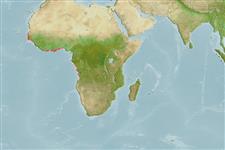Classification / Names
Nombres comunes | Sinónimos | Catalog of Fishes(Género, Especie) | ITIS | CoL | WoRMS | Cloffa
>
Perciformes/Serranoidei (Groupers) >
Serranidae (Sea basses: groupers and fairy basslets)
Etymology: Serranus: Latin, serran, serranus, saw and a fish of genus Serranus (Ref. 45335); inexpectatus: Name from Latin meaning unexpected, referring to the surprising find of an undescribed species in the collection of Zoologische Staatssammkung museum.
Environment: milieu / climate zone / depth range / distribution range
Ecología
marino asociado a arrecife; rango de profundidad 25 - 36 m (Ref. 118671). Tropical
Distribución
Países | Áreas FAO | Ecosistemas | Ocurrencias, apariciones | Point map | Introducciones | Faunafri
Eastern Central Atlantic: Senegal, Gabon and Angola; and possibly Sierra Leone.
Tamaño / Peso / Age
Maturity: Lm ? range ? - ? cm
Max length : 9.2 cm TL macho / no sexado; (Ref. 118671)
Short description
Claves de identificación | Morfología | Morfometría
Espinas dorsales (total) : 10 - 1; Radios blandos dorsales (total) : 12; Espinas anales: 3; Radios blandos anales: 7. This species is distinguished by the following characters: D X,12; A III, 7; gill rakers 5-7 + 10-11, total = 15-18; pseudobranchial filaments about 22; pored lateral line scales 46; circumpeduncular scales 21; scales below D1 origin 4 and below first segmented dorsal ray 3-3.5; truncate caudal fin with upper lobe slightly pointed and the lower somewhat rounded; dorsal, anal and pectoral fins scaly near base; tube-like anterior nostril with rim low anteriorly but rising to a high narrow flap posteriorly, 4-6 long cirri at distal tip; posterior nostril a simple opening lacking a raised rim; a prominent black blotch distally between dorsal fin spines a and 4; body with 5 broad bands and another over nape, with the band under the 5th to 10th spines descending to belly well removed from the pectoral-fin base and to front of anal fin; the band below anterior rays of soft dorsal fin descends to middle of anal-fin base (Ref. 118671).
Found in rocky bottoms (Ref. 118671).
Life cycle and mating behavior
Madurez | Reproducción | Puesta | Huevos | Fecundidad | Larva
Iwamoto, T. and P. Wirtz, 2018. A synopsis of the Eastern and Central Atlantic combers of the genus Serranus (Teleostei: Scorpaeniformes: Serranidae). Proc. Calif. Acad. Sci. 65(1):1-39. (Ref. 118671)
IUCN Red List Status (Ref. 130435: Version 2024-1)
Threat to humans
Harmless
Human uses
Herramientas
Special reports
Download XML
Fuentes de Internet
Estimates based on models
Phylogenetic diversity index (Ref.
82804): PD
50 = 0.5000 [Uniqueness, from 0.5 = low to 2.0 = high].
Bayesian length-weight: a=0.01096 (0.00518 - 0.02319), b=3.05 (2.88 - 3.22), in cm total length, based on LWR estimates for this Genus-body shape (Ref.
93245).
Nivel trófico (Ref.
69278): 3.4 ±0.4 se; based on size and trophs of closest relatives
Resiliencia (Ref.
120179): Alto, población duplicada en un tiempo mínimo inferior a 15 meses (Preliminary K or Fecundity.).
Fishing Vulnerability (Ref.
59153): Low vulnerability (10 of 100).
